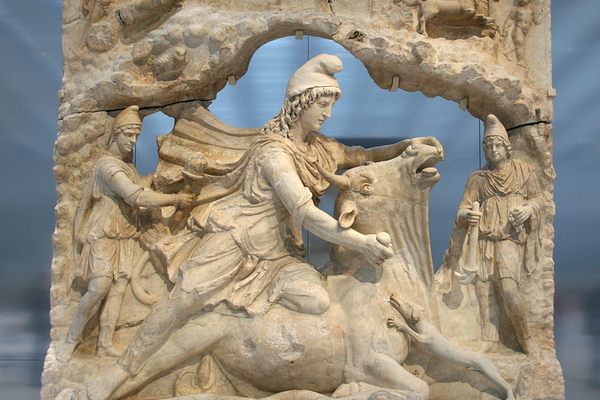

How Cults and Religious Groups Forever Changed American Food
In ‘Holy Food,’ Christina Ward examines how our belief systems end up on the plate.
From the Shakers—a 19th-century bunch of dissenting Quakers who made a mean lemon pie—to the Source Family—a 1970s Californian hippie cult with a celebrity-favorite vegetarian restaurant—to the Church of Jesus Christ of Latter-day Saints (LDS)—whose members abstain from alcohol but fully endorse indulging one’s sweet tooth—religious groups have been making their mark on American cuisine since the Pilgrims wandered onto Plymouth Rock.
In her book, Holy Food: How Cults, Communes, and Religious Movements Influenced What We Eat — An American History, Christina Ward traces the way different belief systems have shaped our dietary preferences—whether we realize it or not.
The Yogi Tea on supermarket shelves, for instance, is a product launched by Yogi Bhajan, a problematic, highly influential guru of the 1970s that many have accused of running a cult. And anyone who’s ever stopped for a maple syrup–soaked sticky bun at one of more than a dozen Yellow Delis across the country has paid a visit to a stronghold of The Twelve Tribes, a proto-Christian sect some have called a “fundamentalist cult.”

While Ward covers a number of insidious organizations, she also points to instances of both secular and religious organizations using food as a form of activism. In the 1970s, the Nation of Islam railed against the forced displacement of Black farmers and overprocessed, nutrient-poor foods as a form of oppression of Black Americans. In response, members of the Nation went back to the land to create a supply of fresh produce. Meanwhile, Bloodroot Collective, a radical lesbian feminist restaurant, continues to serve delicious vegetarian fare to this day.
Gastro Obscura spoke with Ward about America’s sticky relationship with theology, how to know when you’re in a cult, and recipes ranging from The Church of Satan’s panisse to the Pastafarian’s “Flying Spaghetti Monster Holy Noodles.”

Why do you think religions and food impact each other so heavily?
I think that food and religion are so intertwined because food is so essential. It lends itself to so many allegorical relationships to spirituality, especially in the pre-science days. Imagine, all of a sudden people without any understanding of botany realizing you can eat a certain plant. And where did the plant come from? It came from God.
So our existence in earliest times is so tied to that spirituality, the belief that there’s something greater looking out for you. If you take it from there, it becomes imbued in all of the food as we cascade down. Later, if we look at modernity, [food] works as an attractant and also a reflection. The Hari Krishnas are a great example, because their food is pretty good. So they use the food as an example of the positive benefits of their organization.
So that’s one way. Then when we get into the more restrictive cultic stuff, the absence of food becomes a really effective tool for controlling and manipulating behavior, again, because we need it.
The final thing that cements that bond between food and religion is that it also becomes a symbol and a signal to identify both yourself as a member of that tribe or identify others as a member of that tribe. So if you say, “I’m not going to eat onions ever because it’s against my religion,” and you’re amongst other Jains, then that light goes off. People will know you’re part of that system and a system of belief.

Your book is about religions, but I thought it was very interesting that you include several secular groups. Why?
What I saw in my research was that there were two distinct secular pathways that mimicked religious, spiritual communes. There were groups like Bloodroot Collective, who were essentially doing everything that the separatist religious communes and groups were doing—just without the religion.
Then you have groups like the Pastafarians [of the Church of the Flying Spaghetti Monster] and The Satanic Temple—not the Church of Satan, they believe it—who were mocking religion. They were taking an antireligious stance to say, “Okay, we have all these tax laws and benefits to [religious groups].” It becomes a political statement against that type of favoritism.
That’s where it falls under my definition of Is it a religious group?. Because they’re using religion as essentially their meaning—they’re transgressive, they’re anti-religion. You can’t be against something unless that something is there.
A lot of these groups really started out on the fringes, but had a huge cultural impact. What factors helped them attract followers and leave a mark?
That goes back to the whole Is it a cult?. That question of Are you really a cult or are you just cultish? The groups that had an easily accessible message or were very adaptable to who could be in the club lent themselves to more of a mainstream acceptance.
For instance, you couldn’t be in the Source Family unless you wanted to be. You had to make an affirmative choice. And they had all of this public outreach in the 1970s through their restaurant. That was the attractant. The ones that were more open to and interacting with the public were the ones that were obviously accepted more by the public. We see that still today.

When does a religion become a cult, in your opinion?
I really opened my mind a little bit. Steve Hassan, who’s a researcher and a former Moonie, put together something called the BITE Model of Authoritarian Control. It’s a fantastic light assessment tool available to everybody. Many religions will tick a few boxes on the BITE Model of controlling a behavior, a thought, a feeling, or information. But when it’s a group that starts ticking off multiples of those, that’s when you’re dealing with a cult.
For example, look at the Unarius group, who emerged around the same period as the Source Family. They’re really colorful and they lean into the “We’re arty and fun” [vibe]. And they’re still around today, even though their leader also died about two decades ago. But they’re not actively proselytizing. They’re not recruiting. If you’re interested, they’ll talk your ear off about it. They don’t control what you think. They don’t ask you to sever relationships with people.
Those ones are big cult [red flags]. They’re not looking to teach you these methods for stopping your own feelings or how to control others, meaning how to use psychological techniques. Those are the things that, for me, differentiate what’s just a happy-go-lucky, weirdo group versus a dangerous cult.

You point out that it would’ve been easy to just home in on the weirdest, least appetizing recipes from different groups here and that you didn’t want to do that. How did you choose which recipes made the cut?
I was cautious in my approach overall because I am an atheist, meaning I am without religion. I wanted to be really careful because I thought it would be punching down. It would be too easy to go, “Look at what those nuts ate! This is ridiculous!”
I wanted to withhold judgment, and I thought that one of the best ways to do that would be not focus to on the really icky, terrible tasting, bad idea kind of recipes. Then the second part is, as someone who does cook and studies food history, I felt it was a little offensive to purposely waste food.

Were there any recipes you’d recommend making?
The walnut loaf from the House of David [a religious commune in Michigan founded in 1903] is really good.
The Satanic Temple’s panisse looks solid.
That was sent directly to me because I know Lucien [Greaves, co-founder of The Satanic Temple] a little bit and he’s like, “I’ll ask Adam!” So Adam wrote that one up just for me because I really wanted to include the non-religious religions.
Did making these recipes give you a sense of empathy for some of these groups throughout history?
That gave me so much respect for the work involved. Just revisiting the recipes from the 1800s and early 1900s, that’s where the eye-opener was, that we take food for granted in modern times. We have technologies that allow for food storage and preservation. People, I think, forget that that’s a relatively modern invention. Prior to the 1920s, if you didn’t have enough food to last you three days, you might not eat the next day.
I think of those poor people in northern Illinois in the prairies, the Bishop Hill folks. That was one of the groups I focused on as to how it all goes wrong. They just couldn’t catch a break. They had crop failures and made bad decisions and just at every turn got a kick in the gut and they couldn’t survive. That’s part of the new respect in how these folks thrived and figured it out and worked really hard to keep themselves and their people fed.

What is it about America that—I don’t want to say makes us susceptible to cults—but that has helped foster so many of these religious movements?
I think it is us. The reason why is very specific to the First Amendment. And that’s like, “Only in America, kids, we don’t have a state-enforced religion. We don’t have a state relationship with any specific denomination or sect or belief system.”
So that, combined with the freedom of religious expression clause, pretty much clears the decks for anything and anyone. So from the Pastafarians to the Lutherans, you get to do it any way you want. There’s no outside force or governmental force or anything encoded that can stop you.
Was there something that really surprised you in your research?
The interconnectivity between all of these. There’s almost a direct lineage. My husband started watching It’s Always Sunny in Philadelphia and I sometimes feel like Charlie with the conspiracy board. I still have Post-it notes I’m trying to organize about all of these groups because they all knew each other to some extent.
There’s almost direct throughlines from one guy who was marching around in the late 1700s to Mormons today. That, to me, was so surprising because the United States is so big. It really drives home how much influence one singular person with an idea who is lucky, motivated, and has a platform can have over so many.
This interview has been edited and condensed.
Gastro Obscura covers the world’s most wondrous food and drink.
Sign up for our email, delivered twice a week.


















Follow us on Twitter to get the latest on the world's hidden wonders.
Like us on Facebook to get the latest on the world's hidden wonders.
Follow us on Twitter Like us on Facebook